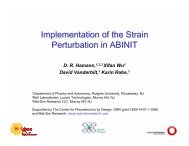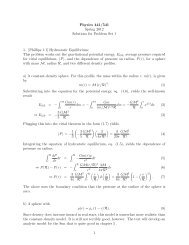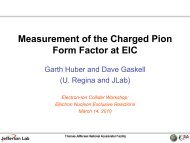Statistics of redshift periodicities
Statistics of redshift periodicities
Statistics of redshift periodicities
Create successful ePaper yourself
Turn your PDF publications into a flip-book with our unique Google optimized e-Paper software.
17<br />
<strong>Statistics</strong> <strong>of</strong> <strong>redshift</strong> <strong>periodicities</strong><br />
W. M. NAPIER<br />
Cardiff University, 2 North Road, Cardiff CF10 3DY<br />
Abstract<br />
Claims that ordinary spiral galaxies and some classes <strong>of</strong> QSO show periodicity<br />
in their <strong>redshift</strong> distributions have been investigated using high-precision data and<br />
rigorous statistical procedures. The <strong>periodicities</strong> are broadly confirmed. They are<br />
easily seen by eye in the data sets. Observational, reduction, or statistical artefacts<br />
do not seem capable <strong>of</strong> accounting for them.<br />
1 Introduction<br />
“Anomalous <strong>redshift</strong>” claims have appeared in the literature for about 30 years<br />
now and are associated with a few astronomers such as H. Arp, the Burbidges,<br />
and W. G. Tifft. The claims are controversial and the author has been engaged in a<br />
long-term project to examine them objectively. Probably the easiest to test are the<br />
claims <strong>of</strong> <strong>redshift</strong> periodicity. The search for periodicity in noisy data has a large<br />
literature and is a well-understood process. Three such claims have so far been<br />
examined, namely the 72 km s −1 periodicity (in the Coma cluster), the 36 km s −1<br />
galactocentric periodicity (in wide-pr<strong>of</strong>ile field spirals), and the periodicity 0.089<br />
in log 10 (1 + z) (in the <strong>redshift</strong>s <strong>of</strong> QSOs close to bright, nearby spirals).<br />
The approach in all cases has been the same: To use high-quality <strong>redshift</strong> data,<br />
not previously used in formulating the hypothesis, and rigorous statistical methods.<br />
Modern computing power now allows one to generate large numbers <strong>of</strong> synthetic<br />
data sets with which the real data can be compared. Here I describe the overall<br />
approach and results rather than the technicalities. The latter can be found in papers<br />
in the reference list.<br />
2 The galactic <strong>periodicities</strong><br />
The initial claim made by Tifft was that the <strong>redshift</strong>s <strong>of</strong> galaxies in the Coma<br />
cluster show a periodicity 72 km s −1 ,aresult that makes no sense in a system<br />
207
208 Current Issues in Cosmology<br />
where the observed radial velocities (presumably virialized) have a dispersion <strong>of</strong><br />
1000 km s −1 .Asecond major claim, made by Tifft and Cocke (1984), was that there<br />
exists a global, galactocentric quantization <strong>of</strong> <strong>redshift</strong>s. For galaxies with narrow<br />
HI pr<strong>of</strong>iles a periodicity <strong>of</strong> 24.2 km s −1 was claimed, while for broad HI pr<strong>of</strong>iles<br />
the claimed periodicity was 36.2 km s −1 .Tosee these latter <strong>periodicities</strong> it was<br />
necessary to correct for a solar motion <strong>of</strong><br />
V ⊙ = 233.6kms −1 , l ⊙ = 98.6 ◦ , b ⊙ = 0.2 ◦<br />
close to the galactocentric solar motion.<br />
Subsequently, a series <strong>of</strong> progressively higher periodic frequencies have been<br />
claimed by Tifft, some <strong>of</strong> which lie on the wrong side <strong>of</strong> the Nyquist frequency. The<br />
current study is concerned only with these initial claims, however. An immediate<br />
problem arises from the fact that, in correcting for the vectorial solar motion, three<br />
free parameters have been introduced. Thus a Hubble flow <strong>of</strong>, say, 72 km s −1 in<br />
a system <strong>of</strong> galaxies with characteristic projected separation 0.5 megaparsec, has<br />
a characteristic velocity separation 36 km s −1 and we can imagine that this might<br />
be made to appear periodic with some “parameter tweaking,” in essence hunting<br />
for periodicity. The way to handle this problem is to construct synthetic data sets,<br />
identical in all respects to the real one except for the periodicity under test, and to<br />
operate on them all, real and synthetic, in identical fashion.<br />
The 72 km s −1 claim was tested by Guthrie and Napier (1990) using 48 spiral<br />
galaxies in the Virgo cluster, which avoided the core and which had well-determined<br />
<strong>redshift</strong>s (formal accuracies σ ≤ 10 km s −1 ). This is the nearest rich cluster <strong>of</strong><br />
galaxies, and had not previously been used to test for <strong>redshift</strong> periodicity claims,<br />
and so is an unbiased sample. Guthrie and Napier (1990) attempted to correct these<br />
<strong>redshift</strong>s for infall towards the Virgo cluster and found that there was indeed a<br />
strong periodicity <strong>of</strong> 71 km s −1 , essentially identical to that claimed for the Coma<br />
cluster.<br />
In Fig. 17.1 the differential <strong>redshift</strong>s <strong>of</strong> the 48 spirals are plotted in the fixed,<br />
galactocentric frame <strong>of</strong> reference. For this plot the latter was taken to be the IAUapproved<br />
V ⊙ = 220 km s −1 , l ⊙ = 90.0 ◦ , b ⊙ = 0.0 ◦<br />
where (V ⊙ , l ⊙ , b ⊙ ) are respectively the speed, galactic longitude, and galactic<br />
latitude <strong>of</strong> the Sun’s velocity vector around the nucleus <strong>of</strong> the Galaxy. The data in<br />
Fig. 17.1 have been smoothed by a standard procedure: The data set is converted<br />
from the velocity to the frequency domain, high frequencies are chopped <strong>of</strong>f, and the<br />
remaining signal is reconverted back to the original velocity domain. It is assumed<br />
that the high frequencies so removed correspond to noise and measurement error
<strong>Statistics</strong> <strong>of</strong> <strong>redshift</strong> <strong>periodicities</strong> 209<br />
1.75<br />
1.5<br />
Count<br />
1.25<br />
1<br />
0.75<br />
0.5<br />
0.25<br />
0<br />
0 142 284 426 568 710 852 994 1136<br />
dV (km/s)<br />
Figure 17.1 Differential <strong>redshift</strong>s dV <strong>of</strong> 48 spiral galaxies in the Virgo cluster. Data<br />
are plotted in the galactocentric frame <strong>of</strong> reference as described in the text, and a<br />
smoothing with cut<strong>of</strong>f 13 km s −1 has been applied corresponding to the rms sum<br />
<strong>of</strong> the formal <strong>redshift</strong> uncertainties. The vertical lines are the best-fit periodicity<br />
<strong>of</strong> 71 km s −1 . The periodicity is illustrated out to 1000 s −1 but extends out to<br />
dV = 3000 km s −1 .<br />
and in the present case the cut-<strong>of</strong>f was taken as 13 km s −1 corresponding to the<br />
RMS sum <strong>of</strong> the measurement errors.<br />
A periodicity is obvious to the eye, and routine power spectrum analysis shows it<br />
again to be ∼71 km s −1 . Allowing for several freedoms (excluding dwarf irregulars<br />
from the study, arbitrariness in defining the “core,” etc.), the periodicity is found<br />
to be significant at a confidence level ∼10 −4 . Since the differential solar motion<br />
correction across the few degrees subtended by the Virgo cluster is small, uncertainties<br />
in this adopted solar apex are second order. In fact the periodicity is observed<br />
strongly over a very wide range <strong>of</strong> solar vectors encompassing the galactocentric<br />
one.<br />
Guthrie and Napier (1996) then tested the ∼36 km s −1 claim for wide-pr<strong>of</strong>ile<br />
spiral galaxies, culling high-precision <strong>redshift</strong> data from the Bottinelli et al.(1990)<br />
catalog, simulations having indicated that for the sample sizes employed the effect<br />
would only be seen in data <strong>of</strong> the highest quality. After excluding data employed by<br />
Tifft and Cocke (1984), there remained 97 spirals with <strong>redshift</strong>s measured formally<br />
to σ ≤ 3kms −1 . Each <strong>redshift</strong> had been measured and reduced by at least five<br />
groups <strong>of</strong> observers using five different radio telescopes. These were generally<br />
galaxies with broad HI pr<strong>of</strong>iles. A remarkably strong periodicity ∼37.5 km s −1 ,<br />
again very close to that claimed, does indeed emerge for vectors in the neighborhood<br />
<strong>of</strong> the solar motion (Fig. 17.2). Significance testing again involves the creation <strong>of</strong>
210 Current Issues in Cosmology<br />
8<br />
Count<br />
6<br />
4<br />
2<br />
0<br />
0 112.5 225 337.5 450 562.5 675<br />
dV (km/sec)<br />
Figure 17.2 Differential <strong>redshift</strong>s dV <strong>of</strong> 97 spiral galaxies in the Local Supercluster<br />
with systemic <strong>redshift</strong>s measured to σ ≤ 3s −1 . Data are plotted in the frame <strong>of</strong><br />
reference V ⊙ = 216 km s −1 ,l ⊙ = 96 ◦ ,b ⊙ =−11 ◦ and smoothed with a cut<strong>of</strong>f<br />
13 s −1 . The vertical lines are the best-fit periodicity <strong>of</strong> 37.5 s −1 . The first 21 cycles<br />
are shown, but in fact the periodicity is detectable out to at least 90 cycles within<br />
the LSC.<br />
synthetic data sets and exploration <strong>of</strong> the power they generate by chance. The<br />
hypothesis <strong>of</strong> non-periodicity is thereby rejected at a significance level ∼10 −5 .<br />
In this case, since the galaxies are scattered over the sky, individual corrections<br />
for the solar motion vary considerably and so the peak powers generated vary<br />
strongly with the adopted solar apex. A real periodic signal occurring in the frame<br />
<strong>of</strong> reference <strong>of</strong> a single velocity generates signals at other velocity vectors and<br />
identifying the “real” signal is not a trivial exercise. To find the “true” solar vector,<br />
the sensitivity <strong>of</strong> the signal to variations in the vector must be decreased. This can<br />
be done in a number <strong>of</strong> ways, but the following approach is particularly instructive.<br />
About half the galaxies in the sample belonged to small groups or associations<br />
containing two to six companions. By looking for periodicity in the differential<br />
<strong>redshift</strong>s within these groups, the sensitivity <strong>of</strong> the signal to V ⊙ may be decreased.<br />
The resulting data set is small (50 galaxies) and so was enhanced by adding galaxies<br />
obtained from a catalog by Tifft (1976) with measured signal-to-noise ratios greater<br />
than 10 and which also belonged to cataloged groups. This enhanced data set<br />
contained 80 galaxies in 28 groups scattered throughout the Local Supercluster.<br />
The power distribution in these 28 LSC groups turns out to have a well-defined<br />
maximum at ∼37.5kms −1 for a solar vector (remarkably!)<br />
V ⊙ = 220 km s −1 , l ⊙ = 90.0 ◦ , b ⊙ = 0.0 ◦
<strong>Statistics</strong> <strong>of</strong> <strong>redshift</strong> <strong>periodicities</strong> 211<br />
It is tempting to assume that the ∼72 km s −1 periodicity found in the Virgo<br />
cluster is a harmonic <strong>of</strong> the ∼37.5kms −1 one found for field galaxies. After all,<br />
a mere 48 spiral galaxies were employed in its derivation, spread over a range <strong>of</strong><br />
∼3000 km s −1 , leaving most “quanta” unoccupied; one can imagine that the higher<br />
frequency oscillation might go undetected, with the power spectrum machinery<br />
settling on a harmonic. However, extensive trials by the author involving synthetic<br />
Virgo clusters with inbuilt ∼37.5kms −1 periodicity have so far failed to yield a<br />
false ∼72 km s −1 one.<br />
Is the ∼37.5 kms −1 periodicity a local phenomenon, peculiar to individual<br />
groups? Or is it global, that is, is there phase coherence from one group to another?<br />
This question was explored by constructing synthetic local superclusters. The procedure<br />
was to preserve the internal relative <strong>redshift</strong>s <strong>of</strong> each group but shift their<br />
systemic <strong>redshift</strong>s bodily by an amount just sufficient to destroy any phase coherence.<br />
Trials indicated that the signal in the real LSC is significantly different from<br />
those in the synthetic ones. Thus the periodicity is a global rather than a local phenomenon,<br />
occurring at least throughout the inner regions <strong>of</strong> the LSC. A bonus <strong>of</strong><br />
these simulations is that they make an “artefact” hypothesis hard to sustain: What<br />
artefact could produce phase coherence in the galactocentric frame <strong>of</strong> reference for<br />
galaxies widely separated over the sky?<br />
3Afixed or variable solar apex?<br />
Although the hypothesis <strong>of</strong> periodicity is preferred over that <strong>of</strong> non-periodicity at<br />
a high confidence level, it is less clear that the “real” periodicity is with respect<br />
to a single, fixed vector. Why should a galaxy 10 megaparsec away care about<br />
the Sun’s motion around the centre <strong>of</strong> our Galaxy? Radial motion with respect to<br />
a local centroid would seem to be another possibility, but to test this one needs<br />
good distance information for galaxies. Karachentsev and Makarov (1996)–hereinafter<br />
KM – have determined a running apex for 103 galaxies within 500 km s −1<br />
<strong>of</strong> the Sun. The overlap with the Bottinelli et al. data set is small – most <strong>of</strong> the<br />
galaxies do not meet the σ
212 Current Issues in Cosmology<br />
480<br />
420<br />
360<br />
velocity (km/s)<br />
300<br />
240<br />
180<br />
120<br />
60<br />
0<br />
−60<br />
−120<br />
−180<br />
0 0.8 1.6 2.4 3.2 4 4.8 5.6 6.4 7.2 8<br />
distance (Mpc)<br />
Figure 17.3 Velocity–distance diagram for 103 galaxies within 500 km s −1 ,inthe<br />
galactocentric frame <strong>of</strong> reference.<br />
higher velocity dispersions for Local Groups, with or without biasing (Governato<br />
et al. 1997).<br />
The remarkably small dispersion ( ∼72 km s −1 ,asithappens) <strong>of</strong> the residuals in<br />
relation to the running apex was also remarked on by KM, who tabulated the velocity<br />
residuals, but for some reason did not plot them. This deficiency is remedied in Fig.<br />
17.4, which reveals clear evidence for structure (the residuals are plotted both raw<br />
and smoothed). A value ∼15 km s −1 was taken for the high-frequency cut-<strong>of</strong>f,<br />
although it is difficult to estimate. Peaks are clearly evident and are consistent with<br />
a periodicity ∼36 km s −1 , relative to the running apex.<br />
Figure 17.5 shows the outcome <strong>of</strong> a search for periodicity in the KM data using<br />
a fixed solar vector. It turns out that there is a periodicity 35.2 km s −1 when one<br />
subtracts out a velocity component corresponding to an apex<br />
V ⊙ = 220 kms −1 , l ⊙ = 100.0 ◦ , b ⊙ =−17.0 ◦<br />
This again illustrates one <strong>of</strong> the problems in analyzing the phenomenon: While<br />
the periodicity is readily observable in high-quality data sets, it is not always clear<br />
which vector is “real,” and which are “ghosts” or “harmonics,” or even whether a<br />
single, fixed vector is involved.
<strong>Statistics</strong> <strong>of</strong> <strong>redshift</strong> <strong>periodicities</strong> 213<br />
3.2<br />
2.4<br />
Count<br />
1.6<br />
0.8<br />
0<br />
0 36 72 108 144 180<br />
velocity residuals ( km/s)<br />
1.25<br />
1<br />
Count<br />
0.75<br />
0.5<br />
0.25<br />
0<br />
0 36 72 108 144 180<br />
velocity residuals (km/s)<br />
Figure 17.4 Distribution <strong>of</strong> velocity residuals for 103 KM galaxies relative to a<br />
running solar apex out to 500 km s −1 . Upper graph: The raw data. Lower graph: The<br />
distribution has been smoothed by removing high-frequency noise corresponding<br />
to a cut-<strong>of</strong>f at 15 km s −1 .
214 Current Issues in Cosmology<br />
0.6<br />
Count<br />
0.45<br />
0.3<br />
0.15<br />
0<br />
−211.2 −70.4 70.4 211.2 352 492.8<br />
velocity (km/sec)<br />
Figure 17.5 Velocities <strong>of</strong> 103 KM galaxies relative to a fixed solar apex as described<br />
in the text. Smoothed with a cut-<strong>of</strong>f at 15 km s −1 . There is a best-fit periodicity <strong>of</strong><br />
35.2 km s −1 .<br />
4 The QSO periodicity claim<br />
The third anomalous <strong>redshift</strong> claim tested so far is that QSOs in the neighborhood<br />
<strong>of</strong> bright, nearby, active spirals show a periodicity <strong>of</strong> 0.089 in log 10 (1 + z). There is<br />
some imprecision in the formulation <strong>of</strong> this hypothesis (what do we mean by close?<br />
By active? What phase should we associate with this periodicity, and with what<br />
standard errors?). The hypothesis was tightened up somewhat by bootstrap sampling<br />
<strong>of</strong> 116 QSOs used by Karlsson (1990)totest it, and fresh data were then employed<br />
as described in Burbidge and Napier (2001), alias BN: These comprised 57 QSO<br />
pairs with separations less than 10 arcseconds, 39 X-ray QSOs near active galaxies<br />
(comprising a complete sample), and 78 3C(R) radio QSOs, again comprising a<br />
virtually complete sample. Figure 17.6 is a histogram <strong>of</strong> the combined Karlsson and<br />
BN data sets: The periodicity is clearly present and seems to extend three cycles<br />
beyond that originally claimed. Monte Carlo trials yield a formal significance level<br />
<strong>of</strong> a few parts in 100 000, whether the null hypothesis is defined through smoothing<br />
<strong>of</strong> the given data or the z-distribution <strong>of</strong> QSOs as a whole.<br />
It has <strong>of</strong>ten been argued that the QSO periodicity is an artefact <strong>of</strong> observational<br />
selection effects (see the discussion in BN). However the data employed here<br />
were selected precisely to avoid such effects. It was also claimed that the result is<br />
a statistical artefact caused by edge effects (Hawkins et al. 2002), but this has been<br />
shown to be erroneous (Napier and Burbidge 2003): inter alia, edge effects were<br />
automatically allowed for in the procedures employed, and the periodicity is easily<br />
seen by eye, without any statistical analysis (Fig. 17.6). Again, however, although<br />
the periodicity is clear, the circumstances under which it arises are not. For example,
<strong>Statistics</strong> <strong>of</strong> <strong>redshift</strong> <strong>periodicities</strong> 215<br />
0.06 0.30 0.60 0.96 1.41 1.96 2.63 3.45 4.47<br />
16<br />
14<br />
12<br />
10<br />
N<br />
8<br />
6<br />
4<br />
2<br />
0<br />
2.6 11.5 20.4 29.3 38.2 47.1 56 64.9 73.8<br />
100log(1+z)<br />
Figure 17.6 Redshift distribution <strong>of</strong> 290 QSOs compiled by Karlsson (1990) and<br />
Burbidge and Napier (2001) inorder to test claims <strong>of</strong> a periodicity 0.089 in log 10<br />
(1 + z). Selection procedures, etc. are discussed in BN.<br />
the Karlsson QSOs are for the most part radio loud. Likewise the QSOs in the BN<br />
data set tend to be noisy. It remains to be seen whether proximity to bright spirals<br />
really is the determining factor.<br />
5 Discussion<br />
The <strong>periodicities</strong> are empirical findings and are neutral about, say, the cosmological<br />
or local provenance <strong>of</strong> QSOs. It is interesting that a log(1 + z) periodicity is predicted<br />
in vacuum-dominated cosmological models, and an oscillating expansion is<br />
also expected in QSSC.<br />
The overall structure <strong>of</strong> our neighborhood, out to at least 10 megaparsec, is one<br />
in which a fractal distribution <strong>of</strong> galaxies expands with remarkable linearity and<br />
coldness, with a <strong>redshift</strong> periodicity superimposed on the expansion. Current CDM<br />
models cannot explain these features. It remains to be seen whether they could be<br />
modified to do so, or whether one needs to think outside the box altogether.<br />
References<br />
Baryshev, Yu. V., Chernin, A. D., & Teerikorpi, P., (2001). Astron. Astrophys., 378, 729.<br />
Bottinelli, L., Gouguenheim, L., Fouqué, P., & Paturel, G., (1990). Astr. Astrophys. Suppl.,<br />
82, 391.<br />
Burbidge, G. & Napier, W. M., (2001). Astron. J., 121, 21.
216 Current Issues in Cosmology<br />
Governato, F., Moore, B., Cen, R. et al., (1997). New Astr., 2, 91.<br />
Guthrie, B. N. G. & Napier, W. M., (1990). Mon. Not. R. Astr. Soc., 243, 431.<br />
Guthrie, B. N. G. & Napier, W. M., (1996). Astron. Astrophys., 310, 353.<br />
Hawkins, E., Maddox, S. J., & Merrifield, M. R., (2002). Mon. Not. R. Astr. Soc., inpress.<br />
Karachentsev, I. D. & Makarov, D. A., (1996). Astron. J., 111, 794.<br />
Karlsson, K. G., (1990). Astron. Astrophys., 239, 50.<br />
Napier, W. M. & Burbidge, G., (2003). Mon. Not. R. Astr. Soc., 342, 601.<br />
Tifft, W. G., (1976). Astrophys. J., 206, 38.<br />
Tifft, W. G. & Cocke, W. J., (1984). Astrophys. J., 287, 492.


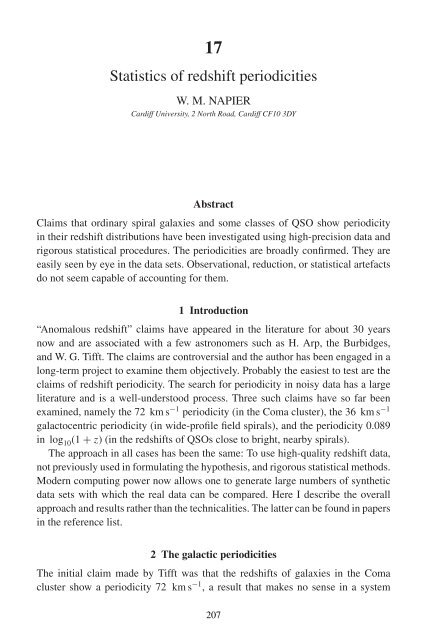
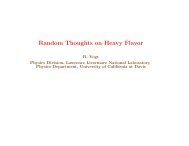

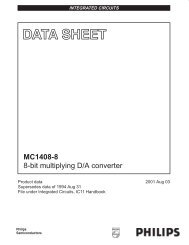

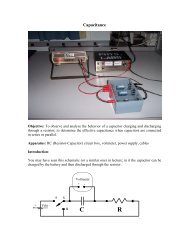


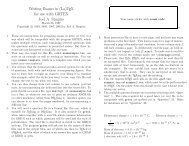
![More Effective C++ [Meyers96]](https://img.yumpu.com/25323611/1/184x260/more-effective-c-meyers96.jpg?quality=85)


